General. Later, mental
The Woolwich, Plumstead & District Cottage Hospital was founded in 1888 by Mr. William Woodford, who remained its Honorary Secretary until 1912.
A half-acre site on Shooters Hill was leased from the Secretary of State for War in December 1888 and the foundation stone for the building was laid by the Duke of Cambridge in September 1889.
The Hospital opened in November 1890. The 3-storey building contained 12 beds, two of which were reserved for private patients.
By 1912 the Hospital had 12 beds and 2 cots. Schoolchildren referred by the LCC for removal of tonsils and adenoids accounted for a great number of admissions. The Hospital also undertook herniotomies and minor operations. Out-patients were also seen, although there was no formal Out-Patients Department.
In the early summer of 1913 the wards were closed for three weeks for painting and redecorating. Electric light was installed in the operating theatre and the old ward beds were replaced by new modern bedsteads. In 1914 the ward floors were covered with linoleum and a hot and cold water supply was plumbed to the operating theatre.
After 24 years of opening, the Hospital Committee had become concerned that the Hospital was too small to enjoy economies of scale, the cost of keeping an in-patient in a small hospital was far higher than keeping one in a large hospital, where the same number of staff could look after more patients. More beds were needed to make the Hospital more economically efficient, and the Committee began to consider the possibility of a new site for a larger building. In the meantime, negotiations began with the War Office to lease extra land adjacent to the Hospital to enlarge the current site but, with the country about to go to war, the War Office felt unable to release any land in case it might be needed for future military requirements.
During WW1 the Hospital was considered too small to be used as a war hospital. In February 1916 a conference was held to decide whether to build a new general hospital with 100 beds as a war memorial. It was estimated some £50,000 would be needed for the project, and the Woolwich District War Memorial Hospital Appeal was launched. In the same year the Hospital's founder, Mr William Woodford, died and a commemorative brass plaque in his honour was erected in the building.
By the end of the war in November 1918 £33,000 had been subscribed, but the cost of living had greatly increased and a much larger sum than £50,000 was now needed. Earlier, in August, Major C.E.S. Phillips, of Castle House, Shooters Hill, had offered part of his property as a possible site for the new venture. The Committee agreed to buy Telegraph Field, with an adjacent strip of land, from him.
By November 1920 the Committee had acquired a freehold site of 6.267 acres from Major Phillips, together with Hazelwood House and 7.280 acres of Crown Estate land, freehold, from HM Commissioners of Woods and Forests. The 13.5 acres had cost £4,700. In the meantime the War Office had agreed to rent an additional three-quarters of an acre of land to the Cottage Hospital, enabling the building to be repaired internally and externally, and the grounds to be improved and re-fenced. (The Hospital now had only 11 beds and 2 cots).
Work at the new site began in February 1923, clearing the land for the foundations. The new Hospital with 320 beds was to be built in three stages. The first phase would be to erect the administration building and two ward blocks with 112 beds; building work began in September 1924. In July 1925, when the two ward blocks had been completed to the first floors, the foundation stone was laid by the Duke of Connaught at the northeast side of the main entrance to the administration block.
At the Cottage Hospital a wireless telephony system (radio) had been installed and the bed mattresses replaced with new hair mattresses. In 1926 it was decided that in-patients should be transferred to the new building during the following year.
The first section of the Woolwich & District War Memorial Hospital was officially opened in November 1927 by the Duke of York, accompanied by the Duchess of York (who, on the abdication of King Edward VIII in 1936, became King George VI and Queen Elizabeth). Some 6443 residents of the Borough had died during WW1 and the main administration building contained a Hall of Remembrance as a war memorial to them.
In March 1928 in-patients were transferred from the Cottage Hospital to the new Hospital, but staff remained at the former site until the end of May. It became known as the 'Old Cottage Hospital' and, after some alterations, remained in use as staff accommodation.
Following WW2 it was planned to use the Old Cottage Hospital as a Rehabilitation Centre once the war damage had been repaired and the necessary alterations made.
The Old Cottage Hospital was renamed Castlewood Day Hospital - a day centre for people with mental health problems - during the 1960s, when it became linked with Bexley Hospital.
During one of the many NHS reorganisations, Oxleas NHS Foundation Trust took over the Memorial Hospital, which closed as a general hospital in 1995. Bexley Hospital, also under Oxleas NHS Trust, closed in 2001 but the Castlewood Day Hospital survived as the Castlewood Therapy Centre until 2004, when Oxleas decided to sell it. Services were relocated to the new Erith Centre.
Present status (July 2009)
The building remained vacant for several years and was sold for redevelopment in May 2007. The developers intend to refurbish the derelict building and to build a new house and a 3-storey apartment block at the rear of the site.
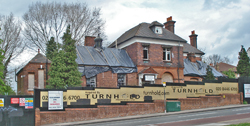
The derelict building has been bought by Turnhold Properties.
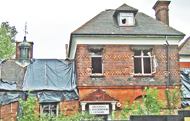
The former Hospital building still bears signage for the Signpost Castlewood Centre. It has been much vandalised and the windows are broken.
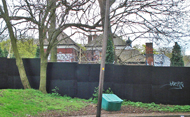
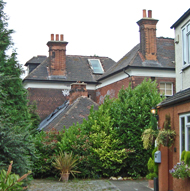
The north side of the Hospital building (left) and the east side (right). Graffiti and missing roof tiles are evident.
Update: October 2012
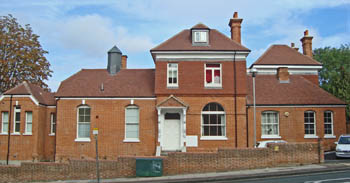
The buildings have been fully restored and converted into five apartments. The front door does not appear to be in use.
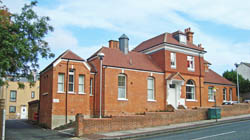
The site also contains a terrace of six houses to the rear of the former Hospital building.
| Average weekly cost of one in-patient in the Woolwich & Plumstead Cottage Hospital (in 1928 patients were transferred to the Woolwich War Memorial Hospital) |
|
| 1918 | £2 16s 11d (£2.85) |
| 1919 | £3 10s 11d (£3.55) |
| 1920 | £3 12s 8d (£3.63) |
| 1921 | £3 15s 2d (£3.76) |
| 1922 | £3 5s 6d (3.27) |
| 1923 | £2 12s 1d (£2.60) |
| 1924 | £2 14s 4d (£2.72) |
| 1925 | £3 1s 6d (£3.07) |
| 1926 | - |
| 1927 | £2 18s 91/2d (£2.94) |
| 1928 | £4 3s 9d (£4.18) |
http://e-shootershill.co.uk
http://onlineplanning.greenwich.gov.uk
www.bexley.gov.uk
www.bexleyhospital.co.uk
www.greenwich.gov.uk
www.oxleas.nhs.uk
www.slam.nhs.uk
www.tribalmjp.co.uk
Return to home page